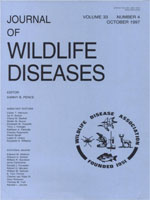A plague (Yersinia pestis) epizootic spread through Gunnison's prairie dogs (Cynomys gunnisoni), and possibly other rodent species, in the Moreno Valley in north-central New Mexico between winter 1984–1985 and autumn 1987. We observed the progress of the epizootic and subsequent population recovery at four prairie dog towns within the valley during this period. At two towns (Midlake and Val Verde) the prairie dogs were marked prior to the epizootic. At two additional towns (Vega and South Entrance) prairie dogs were marked following the epizootic. In 1988, a second epizootic occurred at Vega. One hundred thirty-nine serum samples were collected from prairie dogs and other rodents and 1,750 fleas were collected from animals and burrows. Fleas infected with Y. pestis were collected from prairie dogs, deer mice (Peromyscus maniculatus), and thirteen-lined ground squirrels (Spermophilus tridecemlineatus). Prairie dog fleas included Oropsylla hirsuta, O. labis and O. tuberculata; deermouse associated fleas were Aetheca wagneri and Rhadinopsylla sectilis, and Oropsylla bacchi was associated with thirteen-lined ground squirrels. All of the above flea species were collected from prairie dog burrows. All rodent species shared some flea species. Thirteen-lined ground squirrels disappeared shortly before plague was identified in prairie dogs at Midlake. Meadow voles were rare following the epizootic at Vega in 1986, became abundant in 1987, and disappeared at the time of the second prairie dog epizootic in summer 1988. Although we collected serum from Gunnison's prairie dogs, thirteen-lined ground squirrels, deer mice, and meadow voles (Microtus pennsylvanicus), we identified elevated serum titers against Y. pestis only in Gunnison's prairie dogs. Prairie dog mortality at all towns affected by plague was in excess of 99%. Serum antibody titers indicate that more than 40% of the few prairie dogs left to establish colonies following epizootics survived plague infection.
How to translate text using browser tools
1 October 1997
DYNAMICS OF PLAGUE IN A GUNNISON'S PRAIRIE DOG COLONY COMPLEX FROM NEW MEXICO
Jack F. Cully Jr.,
Allan M. Barnes,
Thomas J. Quan,
Gary Maupln

Journal of Wildlife Diseases
Vol. 33 • No. 4
October 1997
Vol. 33 • No. 4
October 1997
Cynomys gunnisoni
epizootiology
fleas
interspecific transmission
plague
population dynamics
Yersinia pestis




